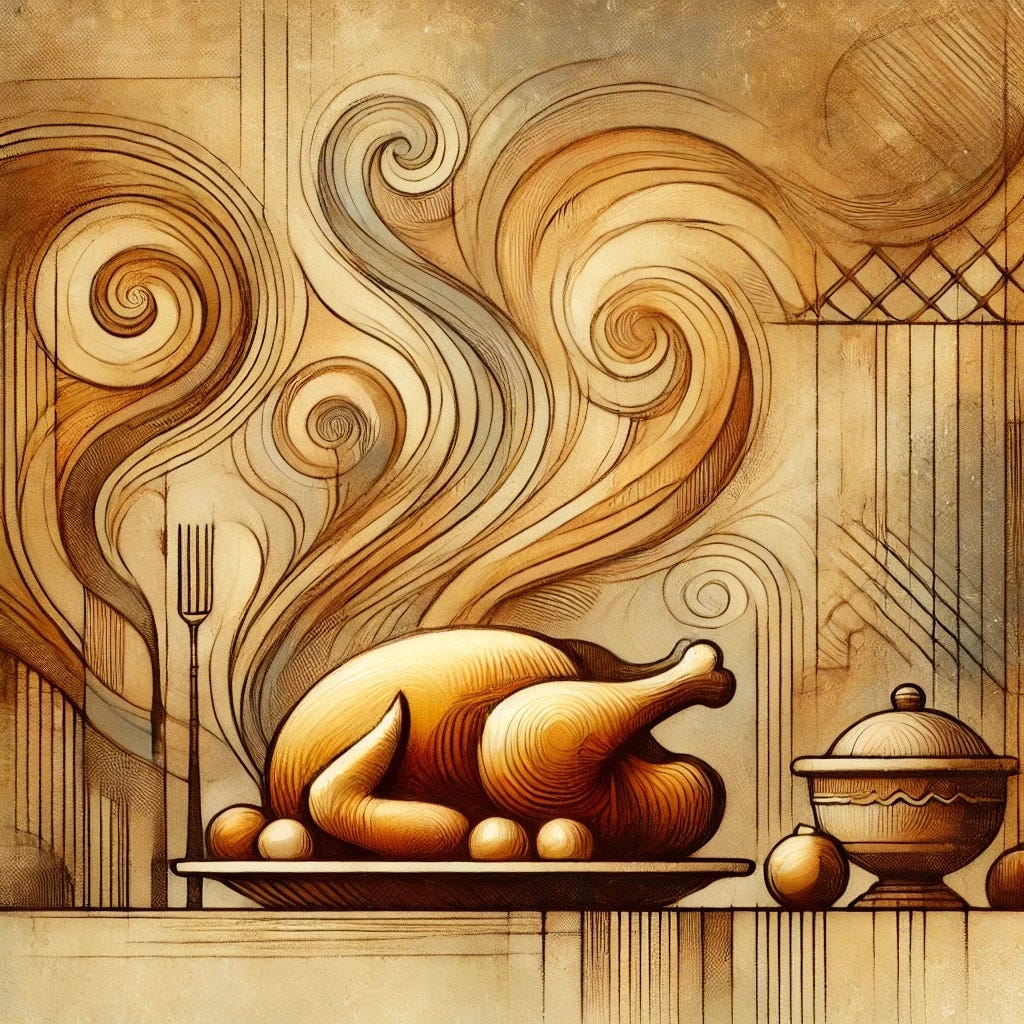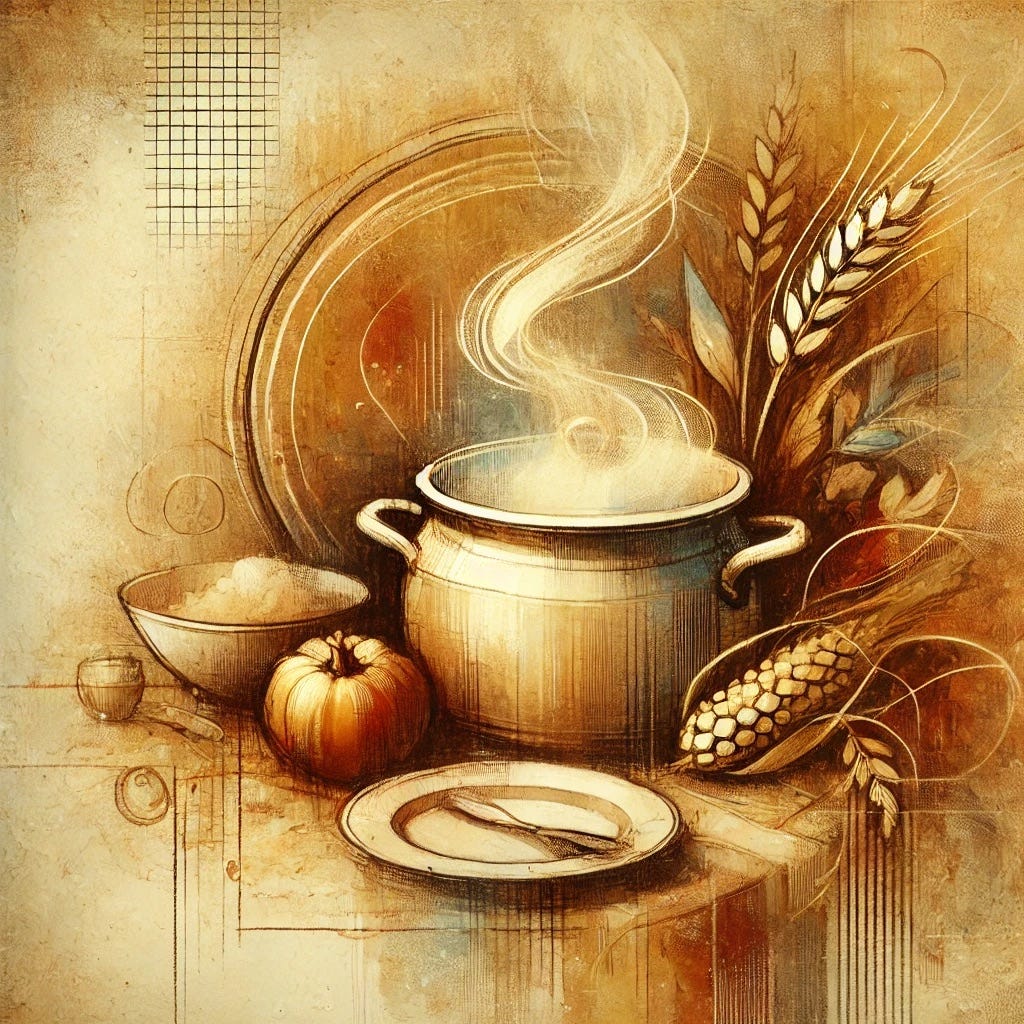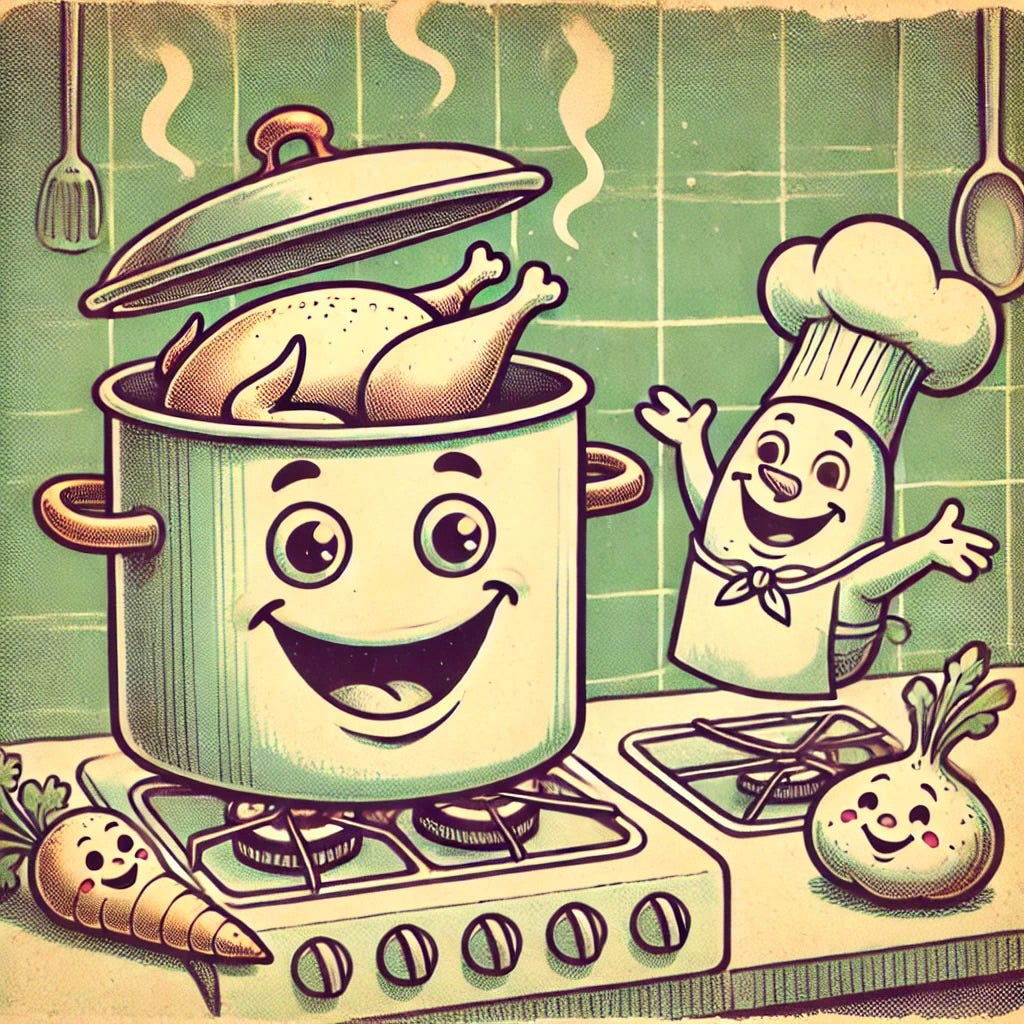Sunday E-dition: A Chicken in Every Pot
By Georgeanne Brennan
Having endured fires in our own region and felt the power of global support, our hearts are with those impacted by the Los Angeles County fires. Napa Valley Features will donate 10% of all new paid subscriptions through January to aid relief efforts.
NAPA VALLEY, Calif. — For the people of France, King Henri IV’s wish for all his peasants to have a chicken in every pot on Sunday was a wish for universal prosperity. Whether he really said it or not is disputed. In 1928, 350 years later, President Herbert Hoover made a similar promise, plus a car in every garage. Actually, it wasn’t Hoover who declared it, either, but a slogan embedded in a newspaper ad created by a Republican election campaign committee that became attributed to the president.
However, like many good slogans, there is both truth and longing in it. A whole chicken was a luxury in Henri’s time and to a lesser extent in Hoover’s. To have a whole chicken on the table, whether in a pot or on a platter, meant that the household didn’t have to parcel the bird out, bit by bit, making it stretch to multiple meals and mouths, but could savor it in its entirety, all at one sitting, indicating if not wealth, at least a modest prosperity.
I sometimes feel that way myself. A crispy, golden-skinned chicken, fresh out of the oven and ensconced on a platter or a steaming pot of chicken and vegetables does make the meal seem like an occasion, a Sunday supper moment, a small celebration and that for the moment all is well with the world.
“Although rotisserie chickens are the standard for whole chickens and are readily available, however, I’d like to make a case for old-school roasted chicken, made at home."
Today’s most popular version of whole chicken, both in France and the United States, is rotisserie chicken, a possible throwback to the Middle Ages, when spits large enough to hold a wild boar were standard fare in the huge fireplaces of castle kitchens and small dogs, called turnspits, kept the meats turning before the fire. Or more rustically, a couple of V-shaped sticks stuck in the ground to hold a third stick with a roasting bird, this to be turned by hand over an outside fire pit.
That rotisserie chickens rule the roost in France is evident at any famers market, where the longest lines are for the takeaway chickens. Rows of succulent birds browning as they slowly turn on the mobile truck’s motorized spits, their aroma floating on the air, the fat drippings seasoning the potatoes, onions and peppers in the pans below are the markets’ main attraction.
If shoppers miss the market, they can almost always count on getting a chicken to go from the rotisserie at their supermarkets’ meat departments or from a local butcher, many of whom have small rotisseries outside their shops.
It seems Henri IV’s wish has come true, but in a slightly different form. His chicken in every pot was most likely Poule au Pot, a whole chicken stuffed with various other meats, then slowly poached in vegetable-laden broth. First the broth would be served, followed by the chicken and its stuffing. Poule au Pot is an old-fashioned dish – the recipe dating back hundreds of years, but it is still served at Sunday tables across France in a slightly more streamlined version.
Hoover (or at least his campaign) got his wish for chicken, as well, at least in the Bay Area. Like in France, our farmers’ markets have mobile rotisserie trucks, spits speared with gently turning chickens waiting to be taken home.
Roli Roti, founded in 2002 in San Francisco by Thomas Odermatt, from a Swiss butcher family, was an immediate success. At first, with only one truck, Odermatt not only drove to as many markets as he could with his ware, he even catered as far away as Capay Organic farm in Yolo County, for an event I was proud to organize. Today he has six trucks, continues to cater and to go to farmers markets from San Rafael to Santa Cruz. Roadside Rotisserie, which can be found at the Saturday farmers market in Napa, has multiple trucks as well, traveling throughout the Bay Area farmers markets. And, as in France, if you miss the chicken on market day, supermarkets such as Whole Foods and Nuggets produce their own versions, ready to take home.
Although rotisserie chickens are the standard for whole chickens and are readily available, however, I’d like to make a case for old-school roasted chicken, made at home. Fresh, organic chickens, locally raised and produced by Channa Ranch in the Capay Valley, are available at the Napa farmers market. Fatted Calf carries Fogline and Root Down organic chickens from farms near Pescadero, and of course, the pioneering brands, Organic Rosie and Free Range Rocky, of Petaluma Poultry (now a subsidiary of Perdue Farms) are readily available, as are Mary’s Free Range chickens from the family farm in Sanger, California.
If you roast your own chicken, you still get the crackling skin and juicy, moist meat, but you also get to choose your own seasonings, add vegetables if you want — even stuffing — and of course, there will be plenty of jus.
ROAST CHICKEN AND POTATOES, FRENCH ROTISSERIE STYLE
This is my home version of a French-style rotisserie chicken, potatoes, peppers, onions, drippings and all. To replicate those jus-bathed potatoes, I position the chicken on a rack in a roasting pan with the potatoes beneath.
Start to finish: 2 hours
Servings: 4 to 6
1 chicken, about 4 pounds
2 teaspoons sea salt
2 teaspoons freshly ground black pepper
3 or 4 sprigs fresh rosemary
3 or 4 sprigs fresh thyme
2 fresh bay leaves or 1 dried
8 -10 small Yukon Gold potatoes, peeling optional
1 large onion, chopped
2 red sweet peppers, seeded and cut lengthwise into ½-inch-wide strips
1 tablespoon butter, divided use
Preheat an oven to 350 degrees F. Rub the chicken well, inside and out with the salt, pepper, rosemary and thyme. Place the rosemary and thyme sprigs in the chicken cavity along with the 2 bay leaves. Place the chicken on the rack of a roasting pan just large enough to hold it and place it in the oven, uncovered.
Put the potatoes in a large saucepan and cover with 1 inch of water. Bring to a boil, then reduce the heat to medium, cover the potatoes and parboil until just beginning to become tender, about 15 minutes. Remove and drain.
After the chicken has been roasting for 30 minutes, remove the pan from the oven and lift up the chicken and rack. Place the parboiled potatoes in the bottom of the roasting pan along with the onions and peppers and dot with half the butter.
Replace the chicken and rack in the roasting pan and rub the chicken all over with the remaining butter. Return to the oven and continue to roast until the chicken is golden brown, the juice runs clear at the thigh when pierced with the tip of a knife and the potatoes are also tender when pierced with the knife, another 30 to 45 minutes.
To serve, remove the chicken to a cutting board and let it rest 10 minutes before carving it into serving pieces. Pour any collected juices into the roasting pan with the potatoes and vegetables. Arrange the chicken on a platter and spoon the roasting pan juices over it, then arrange the potatoes and vegetables around the chicken or serve them separately in a bowl.
POULE AU POT
Poule au Pot, or poached whole chicken in a pot, is a classic Sunday dish in France that is always well-received. This version calls for stuffing the chicken before cooking it. Any bits that escape will help flavor the broth with the soft, dumpling-like morsels. Serve the broth as a first course with warm bread, followed by the carved chicken and the vegetables and accompanied by Dijon mustard, cornichons and mayonnaise or aioli. The ingredient list is long, but this is actually quite a straightforward dish.
Start to finish: 4 hours
Servings: 4 to 6
1 chicken, about 4 pounds
For the broth:
5 quarts water or 2 1/2 quarts chicken stock and 2 1/2 quarts water
1 onion
6 cloves
2 cloves garlic
6 black peppercorns
3 to 4 large leeks, divided use
6 to 8 carrots, divided use
2 stalks celery
3 sprigs parsley
2 bay leaves
2 teaspoons coarse sea salt or more as needed to taste
For the stuffing:
1 tablespoon butter
2 tablespoons chopped pancetta or bacon
¼ cup finely chopped onion
1 garlic clove, minced
¼ cup chopped Italian parsley
6 to 8 slices day-old baguette or coarse country bread
1 teaspoon sea salt
1/4 teaspoon freshly ground black pepper
¼ teaspoon cayenne pepper
1 teaspoon fresh thyme leaves
¼ pound bulk pork sausage
1 egg, lightly beaten
1/2 cup hot water if needed
To finish:
6 small turnips, peeled and quartered
4 small rutabagas, peeled and quartered
Remove the giblets from the chicken and set aside. Pat the chicken dry and refrigerate until ready to use.
For the broth: Put the water or stock and water into a large stock pot and start to bring to a boil over high heat. Stick the cloves into the onion, peel and crush the garlic and add these to the pot along with the peppercorns. Trim the leeks, cutting off the dark green leaves, leaving an inch or so of pale green on the stalk. Set aside the leek stalks and green leaves.
Peel and cut the carrots in half. Add 4 halves to the pot, reserving the rest. Add half of the leek and green leaves, reserving the rest for another use. Add the celery, parsley sprigs, bay leaves, salt and giblets.
After the stock has reached a boil, reduce the heat to medium and continue to cook, uncovered until it has reduced to about 3 quarts, one hour to 1 hour and 15 minutes.
For the chicken: Melt the butter in a frying pan over medium heat and when it foams, add the pancetta, onion and garlic and sauté until the onion is translucent, about 2 minutes. Remove to a bowl and add the parsley. Remove the crust from the bread and tear or cut it into smallish pieces. Add these to the bowl, along with the salt, pepper, cayenne, thyme, sausage and egg. Mix well. The stuffing should be moist and somewhat sticky. If too dry, add a little of the hot water to moisten. Cover and refrigerate until ready to use.
When the broth is reduced, remove and discard the vegetables and the giblets.
Fill the cavity of the chicken with the stuffing, packing it loosely. With a threaded trussing needle or metal trussing pins, close the cavity. Tie the legs together as they cross behind the closed cavity.
To have a whole chicken on the table, whether in a pot or on a platter, meant a household could savor it in its entirety, signaling modest prosperity.
Add the stuffed, trussed chicken to the broth and bring to a boil. Reduce the heat to medium-low, and skim off the foam that comes to the surface. Cover and cook about 45 minutes, then add the remaining carrot halves, the rutabagas and turnips. Cut the leeks in half and add those as well.
Continue to cook until the juices of the chicken run clear at the thigh when pierced with the tines of a fork and the vegetables are tender, about another 30 to 40 minutes.
Remove the chicken and vegetables to a platter, cover with foil and keep warm. Skim the surface of the broth, removing the fat. Taste and adjust with salt as needed. For the first course, ladle about one cup of the broth into each of 4 or 6 individual soup bowls, reserving about 2 cups for the chicken and vegetables.
To serve the chicken, carve it and arrange the pieces on a warm platter. Scoop out the stuffing from the cavity and put it in a bowl or on the platter. Arrange the carrots, leeks, turnips and rutabagas around the chicken. Reheat the broth if it has cooled and ladle a little over the chicken and vegetables. Serve with Dijon mustard, cornichons and mayonnaise.
If today’s story captured your interest, explore these related articles:
Weekender Encore: Blood, Sweat, Tears and Passion – Creating the BottleRock Lineup
Under the Hood: Napa’s Fatted Calf and the Revival of Charcuterie
Sunday E-dition: Isn't It Romantic? Inside Steve Sando's Kingdom of Beans
Sunday E-dition: Rediscovering Quince, California's Forgotten Fall Fruit
Explore all Napa Valley Features stories on our main page.
Georgeanne Brennan is an award-winning cookbook author who divides her time between her farm in Northern California and a home in Provence. Learn more about her at her website.
Poem of the Day
“Hope” is the thing with feathers
By Emily Dickinson
“Hope” is the thing with feathers
That perches in the soul
And sings the tune without the words
And never stops at all,
And sweetest in the Gale is heard
And sore must be the storm
That could abash the little Bird
That kept so many warm.
I’ve heard it in the chillest land
And on the strangest Sea
Yet never in Extremity,
It asked a crumb of me.
—
Are you a poet, or do you have a favorite piece of verse you'd like to share? Napa Valley Features invites you to submit your poems for consideration in this series. Email your submissions to napavalleyfeatures@gmail.com with the subject line: "Poem of the Day Submission." Selected poets will receive a one-year paid subscription to Napa Valley Features (a $60 value). We can’t wait to hear from you.
Levity Corner
Caption contest: Pick your favorite caption or add your own in the comments below.
Possible captions:
"The true face of compromise."
"Opposites attract, but no one said it would be this uncomfortable."
"‘Meet in the middle,’ they said. This is the middle?"
"Together, we’ve mastered the art of the perfect storm."
"And I’m the dramatic one?"
Last week’s contest results
In “Sunday E-dition: Setting Mental Health Intentions for 2025,” the winning caption was, "They said to clear my mind, not my floor,” with 75% of the votes.
"The secret is inner peace ... is a really strong blind spot."
"The sunset is calm, the room is not, but I am Zen."
"They said to clear my mind, not my floor."
"Zen mode: engaged. Clean mode: still buffering."
“Caption Haiku:
Dog sits, calm and still,
I’m starting to think he’s wise—
My guru at last.
Last Week
David Kerns detailed the intricate process of crafting the 2025 BottleRock Napa Valley lineup in his article, "Blood, Sweat, Tears and Passion." He explored how Latitude 38 Entertainment, led by Talent Buyer Tom Hoppa, balances artist availability, budgets, audience demographics and tour schedules to book headliners such as Green Day, Justin Timberlake and Noah Kahan. Hoppa shared insights into the complexities of negotiations, the importance of festivalgoer experience and the ongoing adjustments required to finalize daily lineups. He also reflected on the personal passion driving his commitment to crafting high-quality festival experiences. The event is set for May 23-25 in Napa Valley.
Dan Berger examined the evolving attitudes of wine enthusiasts in "Dan Berger’s Wine Chronicles: Bored With Wine?" He discussed how technical jargon and snobbish attitudes among some aficionados can drain the joy from wine appreciation, turning it into a rigid, overly analytical experience. Berger argued for a flexible, open-minded approach to wine that prioritizes enjoyment and discovery over perfection or prestige. He also highlighted the pitfalls of subjective judgments and emphasized that genuine passion and curiosity lead to deeper wine appreciation.
Bob Figoni reported on the Napa County Board of Supervisors’ approval of the Plastic Bag Ban and Reusable Foodware Ordinance in his article, "County Acts to Reduce Plastic Waste and Disposable Foodware." The ordinance, effective in a year, strengthens the state’s plastic bag ban and implements stricter rules on single-use foodware, such as requiring compostable takeout items, banning plastic bags and polystyrene, and adding a 25-cent fee for disposables. Figoni highlighted the ordinance’s environmental benefits, including reducing litter, protecting wildlife and cutting greenhouse gas emissions, and he encouraged businesses and consumers to embrace reusable options. He also urged local municipalities to adopt similar measures for consistent environmental protection across Napa Valley.
Charlotte Hajer and Jessica Musgrove-Ortiz explored setting mental health intentions for 2025 in their article, "Sunday E-dition: Setting Mental Health Intentions for 2025." They encouraged readers to prioritize mental wellbeing alongside physical health, focusing on self-compassion, mindfulness, gratitude, and building social connections. Musgrove-Ortiz recommended starting small, embracing flexibility and viewing intentions as guiding principles rather than rigid goals. The authors also highlighted the importance of self-care practices and seeking support when needed, pointing to local resources such as Mentis for accessible mental health services.
Pat Hitchcock recounted a Napa County Master Gardeners’ field trial with cabbage in her article, “Cabbage Trials: Lessons From the Garden.” Volunteers tested three varieties — Ruby Ball Improved, Katarina, and Alcosa — over two planting seasons, facing challenges like rodents, pests and unseasonal weather. Despite obstacles, most participants reported success, particularly with the green and Savoy varieties, and many expressed plans to grow cabbage again. Hitchcock emphasized the value of hands-on gardening experience and how it can foster appreciation for even less familiar crops.
Tim Carl analyzed Napa Valley's shifting economic landscape in "Under the Hood: Napa Valley’s Economic Reckoning," highlighting stagnation in the region’s real GDP since 2018. He outlined challenges facing the wine and tourism industries, including climate change, rising insurance costs, declining wine demand and lagging post-pandemic tourism recovery. Carl contrasted this with the region's economic boom from 2011-2016 and presented three potential scenarios for 2035, ranging from modest growth to severe contraction.











As the daughter of a mother who loved to cook, when she had time, and who also loved to write about food and its importance in bringing people together, today's article absolutely "sucked me in." I could smell and taste the chickens as you spoke about them, and I am ready to add a whole chicken to my shopping list for tomorrow, just to draw out the enjoyment I had reading your words. Many thanks! I plan to share your piece, always in hope of brining more good people to Napa Vally Features! Have a great week!